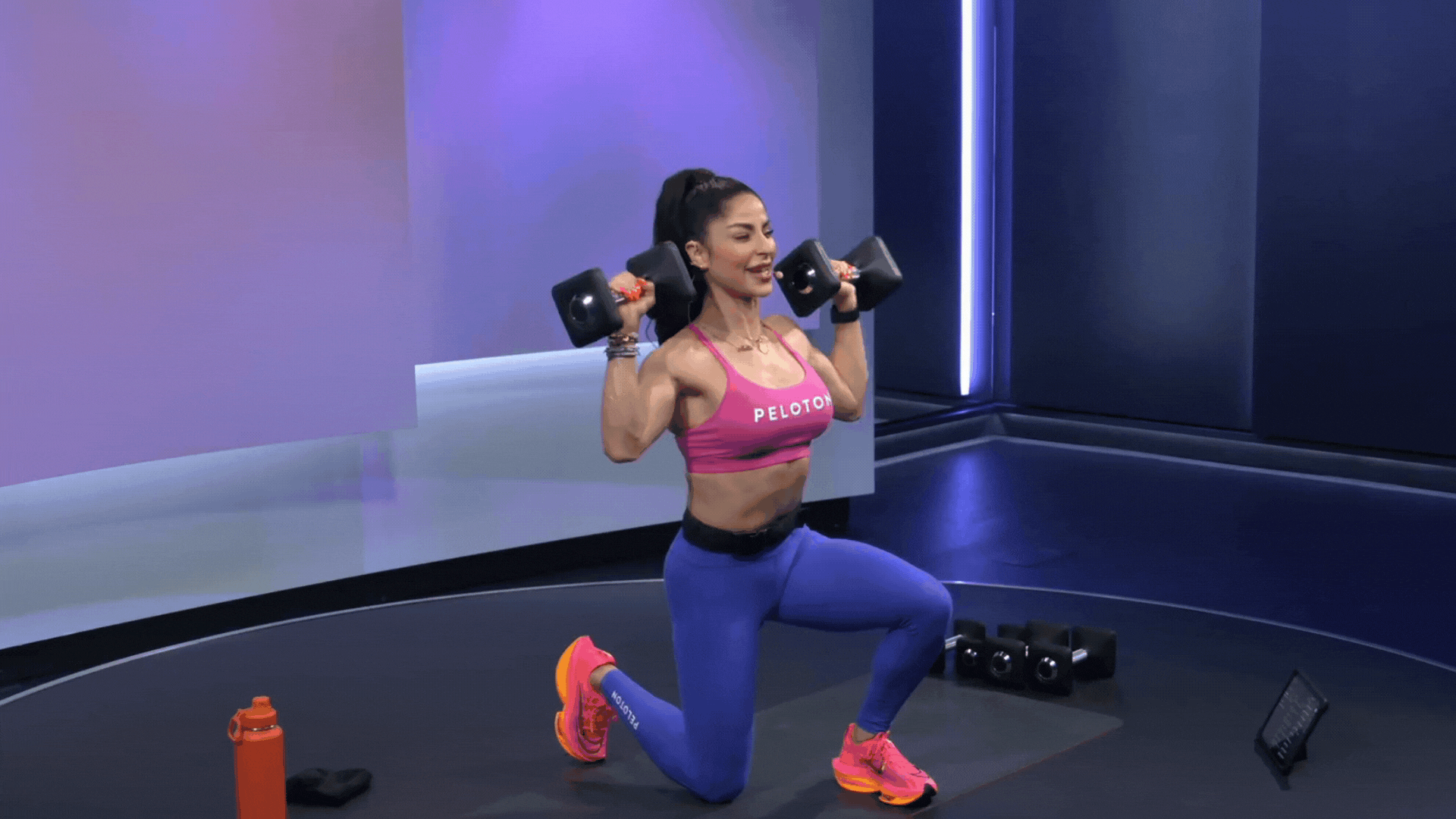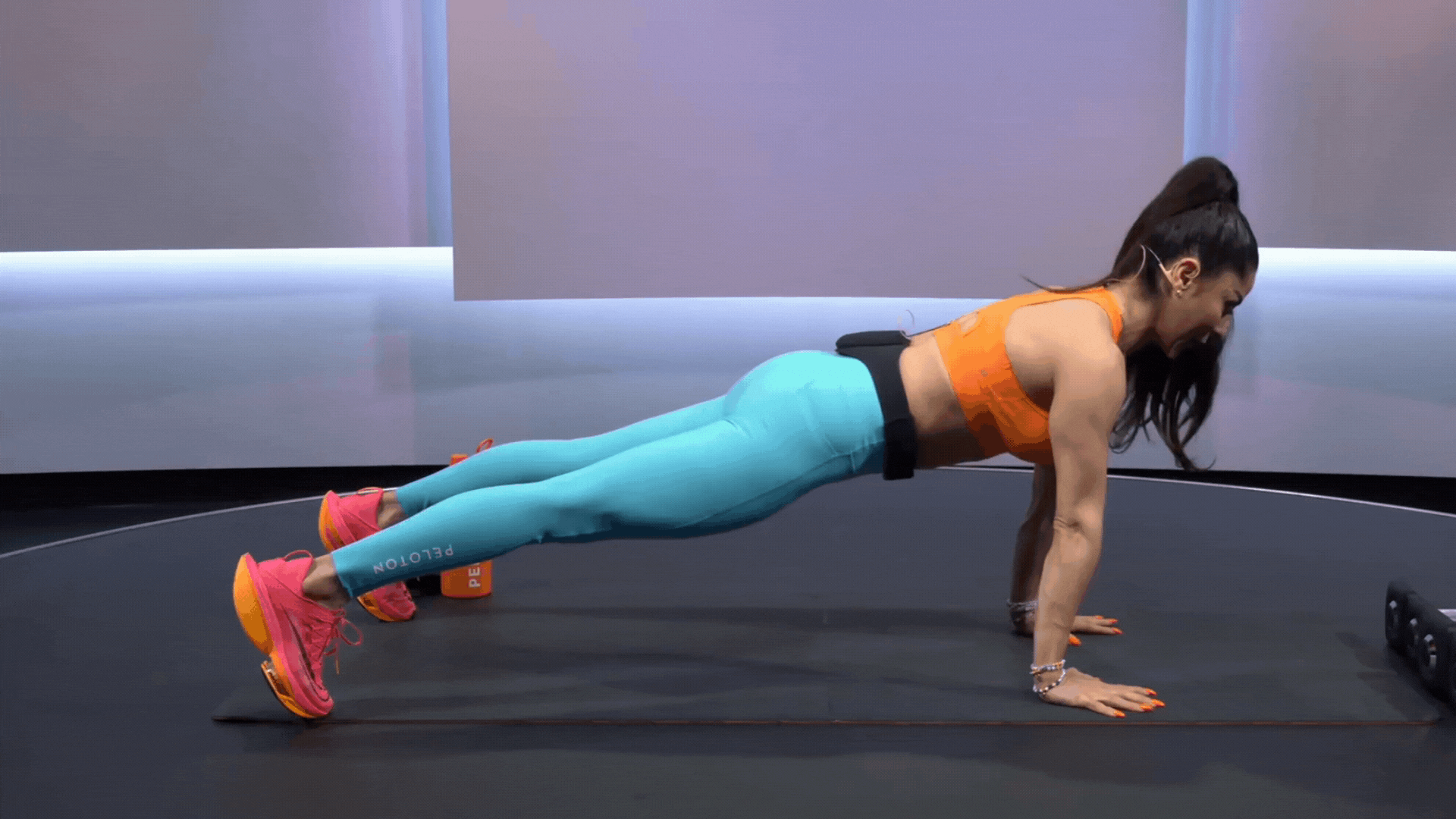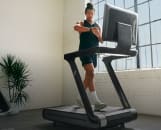
Why Compound Exercises Are the Key to Being Fit for Life
Short on time but looking for a complete workout? Compound exercises will get the job done.
By Alyssa Sparacino•
When it comes to programming a workout—whether you’re following along with a Peloton Gym workout or taking a strength class—there are so many ways to target various muscle groups. And while there’s merit to lots of different techniques, when it comes to being efficient, comprehensive, and, frankly, just fun, compound exercises are it.
What Are Compound Exercises?
“A compound exercise is a multi-joint movement that works multiple muscle groups at the same time,” says Peloton instructor Assal Arian. “A good example of a compound exercise is the squat. It uses many muscles in the lower body, such as the quadriceps, hamstrings, calves, glutes, as well as engaging the core and lower back.” Not only does a squat target many muscle groups, but it’s also considered a compound exercise because you utilize multiple joints, including the hips, knees, and ankles.
But trust that you don’t have to bore yourself with a billion of the same moves to apply this technique. Compound exercises can range from fairly standard, to creative, complex, and quite challenging. This training style can really keep you engaged in your workout.
Compound vs. Isolation Exercises
If a compound exercise targets multiple joints and muscle groups, then, you guessed it: Isolation exercises focus on one muscle or muscle group and one joint, says Assal. “Both compound and isolation exercises have their place in a well-rounded workout,” she says. You can find entire workouts that utilize one or the other type of training style and others that include a mix of the two. For example, bodybuilding often utilizes isolation exercises to target specific muscles with the goal of increasing muscle size, whereas HIIT classes tend to utilize compound exercises for a full-body workout.
There are advantages to both compound exercises and isolation exercises. Here are some of the biggest benefits of each to keep in mind, according to Assal:
Benefits of Compound Exercises
Builds strength. Compound exercises help you build overall strength more quickly, which means you’ll be picking up heavier weights in no time. Bonus: Many compound exercises also improve power, too.
Helps you train for everyday life. “Compound exercises focus on functional fitness developed by exercises that can simulate real-life activities,” says Assal.
Efficiency. Time is precious, and you don’t always have 60 minutes for a workout. Compound exercises “allow you to work more muscles in a short space of time,” says Assal.
Higher energy expenditure. If calorie burn is what you’re after, compound exercises will burn more calories per exercise compared to isolation exercises simply because more muscles are being engaged.
Improves coordination and balance. With a variety of movement patterns and a wide range of motion, compound exercises improve joint mobility and both joint and muscular stability. This is particularly true in some of the more complex compound exercises.
Boosts heart rate. You’re asking more of your body, therefore your heart is pumping oxygenated blood at a faster clip while performing compound exercises, making them a great strength-and-cardio combo.
Benefits of Isolation Exercises
Activates muscles. For various reasons, some muscles can need more encouragement to get going. Isolation exercises can be used during a warm-up or beginning of a workout to ensure sleepy glutes, for example, are fired on so when you continue with your workout the proper muscles are being engaged.
Isolates individual muscle groups. Depending on your goals, you may have specific muscle groups you hope to target—say your triceps, or lats—in your workouts. Isolation exercises are made to do just that.
Great for split-style training. If you’re looking to zero in on a certain area of the body during each workout (think: chest day and leg day) isolation exercises can help you do that while making sure there’s ample time for recovery between targeted sessions.
Helps you rehab. If you’re coming back from an injury, isolation exercises can make sure you don’t overwork parts of the body that aren’t 100 percent back in action. What’s more, if you are trying to strengthen a particular muscle post-injury, isolation exercises can also help you safely do that.
Improves muscle imbalances. It’s incredibly common to have muscle imbalances throughout the body, such as if one hamstring is stronger or more flexible than the other. Isolation exercises can help you zone in and, through continued work, aim to even out those imbalances.
The Best Compound Exercises
Ready to add compound exercises into your workout routine or amp up your next full-body day with new creative moves? Here are Assal’s picks for the best upper- and lower-body compound exercises as well as full-body moves to really get the biggest fitness bang for your buck.
Compound Upper-Body Exercises
Chest Press

Lie on the floor on your back with feet on the ground and knees bent, holding a dumbbell in each hand. (You can also do this compound exercise on a bench.)
Elbows should be roughly 45-degrees out to your sides—not too tight to your ribs nor directly out to the sides. Palms should face your feet.
Press dumbbells up toward the ceiling so they are above your chest (not your face).
Slowly bend elbows to lower the dumbbells toward the chest and triceps toward the floor. Repeat.
Muscles worked: chest, triceps, and shoulders
Overhead Press

Stand with feet hip-width apart, knees soft, and core engaged. Hold a dumbbell in each hand at shoulder height, just outside of shoulders with palms facing forward, and elbows pointing down.
Press dumbbells straight up overhead, being mindful not to arch your back at the top. Biceps will be close to your ears.
Slowly return to the starting position. Repeat.
Muscles worked: deltoids, triceps, upper back, and core
Bent-Over Row

Stand with feet hip-width apart holding a dumbbell in each hand.
Hinge forward at the hips with knees slightly bent, bringing torso between 45 degrees and parallel to the floor, arms extended down. Be mindful not to arch your back.
Engage your lats, draw shoulder blades down, and bend elbows, pointing them back to row the dumbbells up to lower ribs near hips. Keep your arms tight to your sides.
Slowly return to the starting position. Repeat.
Muscles worked: upper back, biceps, posterior deltoids, and lower-back muscles
Push-up

Start in a high plank position with hands under shoulders and legs extended, feet hip-width apart. Engage core, squeeze your glutes, and tuck your pelvis as you draw the navel toward the spine. (Tip: You can also perform a push-up on your knees, but your torso should still be engaged and back flat.)
Bend your elbows out to a 45-degree angle to lower the whole body down, hovering just above the floor. Keep shoulders away from your ears. Keep your neck neutral.
Push through palms to return to starting position. Repeat.
Muscles worked: full-body exercise, emphasizing chest, shoulders, triceps, and core
Compound Lower-Body Exercises
Squat

Stand with feet slightly wider than hip-width apart, toes turned slightly out.
Bend the knees and sit back into hips to lower butt until thighs are roughly parallel to floor, keeping chest lifted.
Press through soles of the feet to return to standing. Repeat.
Muscles worked: quadriceps, hamstrings, and glutes, as well as core and lower back
Deadlift

Stand with feet hip-width apart holding a dumbbell in each hand in front of your thighs, palms facing toward you. Draw your shoulder blades back and down, engage your core.
Hinge at the hips to send them back, keeping just a soft bend in the knees as you lower dumbbells toward the floor stopping roughly mid-shin when you feel your hamstrings catch. Keep back flat.
Push through the soles of your feet to return to standing, squeezing your glutes at the top and being mindful not to overextend or arch your back. Repeat.
Muscles worked: posterior chain (back side of the body), including glutes, hamstrings, lower back, and upper back
Forward Lunge

From standing, step forward with your right foot and bend both knees to lower down until your right thigh is parallel to the floor and both knees form 90-degree angles.
Push through the sole of the front foot to return to starting position.
Repeat on the other side, stepping forward with the left leg, bending both knees to lower down until the right left is parallel to the floor and both knees form 90-degree angles.
Push through the sole of the front foot to return to starting position. Repeat.
Muscles worked: quadriceps, hamstrings, and glutes, and also engages the core—the type of lunge you perform (forward, vs. reverse vs. side, for example) will emphasize different muscles
Full-Body Compound Exercises
The beauty of compound exercises is that they work multiple muscles, but also areas of the body all at once, which makes them great full-body movements, too. Simply combine an upper-body compound exercise with a lower-body compound exercise, and you’ll light up your entire body from head to toe. Think: an overhead press with a reverse lunge, where you press up every time your leg travels back. Talk about workout efficiency!
Some other full-body compound exercises, Assal loves:
Dumbbell Clean and Jerk

Stand with feet hip-width apart holding a dumbbell in each hand. (You’ll need to go a bit heavier for this move.)
Bend knees and hinge at the hips to bring dumbbells down in front of shins in a hanging position. Keep chest lifted, back flat, and core engaged.
In one swift movement, raise chest and thrust hips forward, using the power from your lower body to pop the dumbbells up to shoulder height, landing upright with softly bent knees.
Immediately perform a push press by dipping your legs slightly and thrusting the dumbbells up overhead.
Bring dumbbells back to shoulders before smoothly transitioning into your next rep.
Muscles worked: legs, hips, core, shoulders, and arms
Dumbbell Snatch

Stand with feet hip-width apart, with one dumbbell horizontal on the floor between them. (You’ll want to go heavier for this move.)
Bend knees and come into a squat as you grab the dumbbell with one hand.
In one swift movement, trust hips, bend the elbow of the arm holding the dumbbell, stand, and shoot that arm straight up overhead. The weight should travel up the body, staying tight to the front of you the whole time.
With control, smoothly reverse the movement to transition into your next rep.
Muscles worked: legs, hips, back, core, shoulders, and arms
The Takeaway
To get the most out of your training program, compound exercises are non-negotiable, says Assal, adding "all in all, compound lifts give you the best [results] for strength, muscle size, endurance, fat loss, athleticism, and aesthetics." Sounds pretty convincing, right?
This content is for informational and educational purposes only and does not constitute individualized advice. It is not intended to replace professional medical evaluation, diagnosis, or treatment. Seek the advice of your physician for questions you may have regarding your health or a medical condition. If you are having a medical emergency, call your physician or 911 immediately.
Level up your inbox.
Subscribe for a weekly dose of fitness, plus the latest promos, launches, and events.
By providing your email address, you agree to receive marketing communications from Peloton.
For more about how we use your information, see our Privacy Policy.


